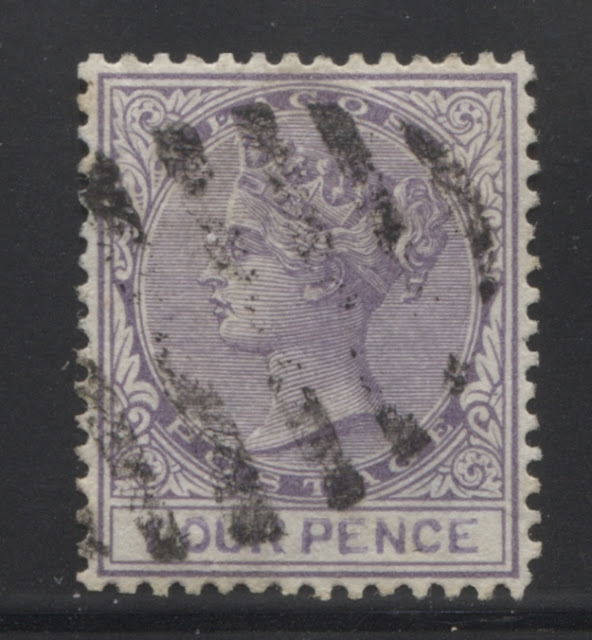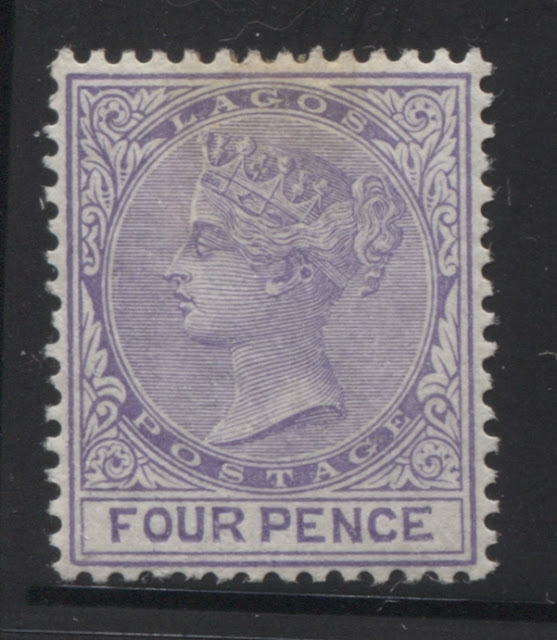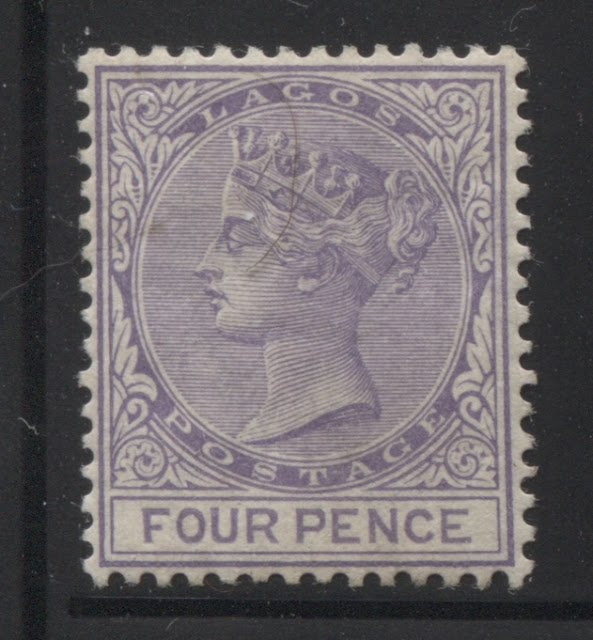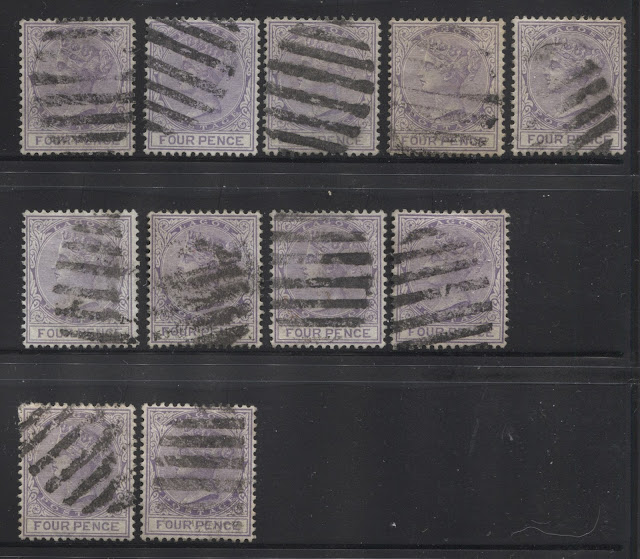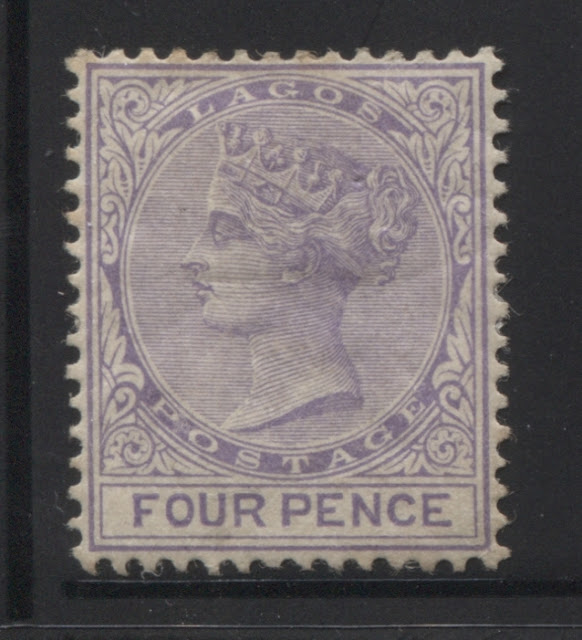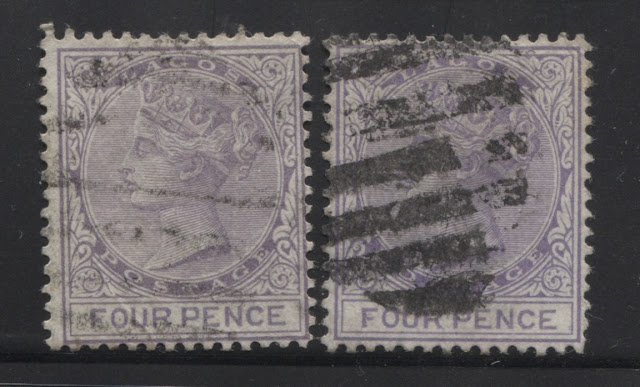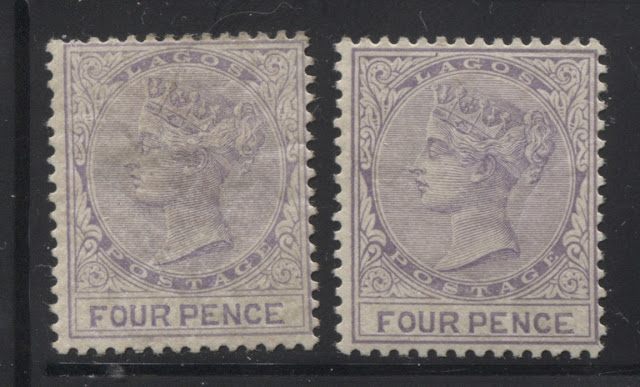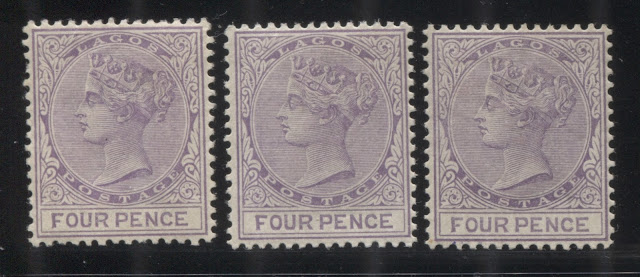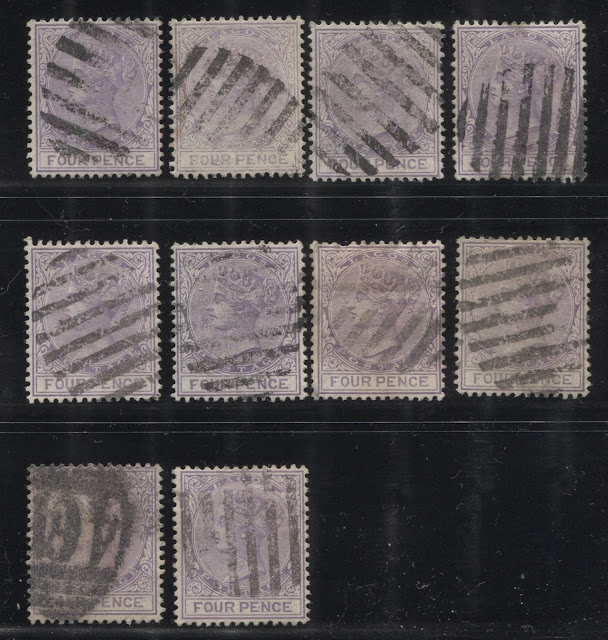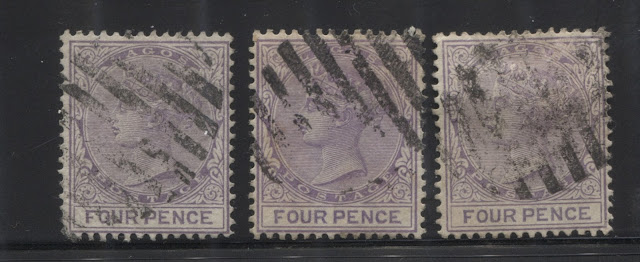Today's post continues my examination of the stamps of the second Crown CA Issue of Lagos, with the 4d Mauve. Between July 1884 and December 1886, 41,760 stamps were dispatched to the colony in 11 different printings as follows:
- July 8, 1884 - 58 sheets of 60, or 3,480 stamps.
- September 24, 1884 - 60 sheets, or 3,600 stamps.
- December 16, 1884 - 60 sheets, or 3,600 stamps
- April 21, 1885 - 60 sheets, or 3,600 stamps.
- July 13, 1885 - 60 sheets, or 3,600 stamps.
- September 29, 1885 - 60 sheets, or 3,600 stamps.
- December 29, 1885 - 62 sheets, or 3,720 stamps.
- March 29, 1886 - 60 sheets, or 3,600 stamps.
- June 30, 1886 - 60 sheets, or 3,600 stamps.
- October 12, 1886 - 76 sheets, or 4,560 stamps.
- December 13, 1886 - 80 sheets, or 4,800 stamps.
As you can see, the last two printings are slightly more common than the others, but by and large the printings are all roughly the same in terms of scarcity. Interestingly, the printing quantities are almost exactly the same for all shipments, as the 2d slate. In only a few shipments did the quantities differ, and they never differ by more than 1-2 sheets. All other things being equal, we can expect most of the existing mint examples on the market today to come from the last three printings. This was a fairly heavily used stamp due to the postage rates at the time, so used examples should be more common than mint for all the printings.
It may not be possible to positively identify all 11 printings, but I am going to attempt in this post to give it a shot using all the information that I can glean from careful study of the cancellations, shades, paper and gum as well as what I have learned from my study of the 2d, 6d, 1/- values that I have studied so far. From these two stamps, I know that:
- All the printings made after April 1886, i.e. the last three printings should come with the colourless double gum that causes the mint stamps to curl vertically. This gum will be smooth and not crackly.
- Printings made between July 1885 and March 1886 will tend to have the smooth, toned single layer of gum that does not cause the stamps to curl, but is not crackly. This would correspond to printings five through eight.
- Printings prior to July 1885, i.e, the first four printings, will be found with crackly gum, or will be found without any gum at all.
- Most copies with CDS cancels dated after 1888 will generally be from the last three printings, as will copies cancelled with the 9-bar oval killers. In the case of the 2d slate that I studied last week, I found that the 9-bar killers were confined almost entirely to the last printing. I'm not sure whether that will be the case here, but we'll see.
- Although the 8-bar oval obliterator was in use until 1897, my expectation is that most copies cancelled with it will have come from the first 8 printings (i.e. before March 1886).
- The very first printing should have a smooth, thick gum that gives the paper a very stiff feel.
To identify the printings, I will be working with 12 mint and 59 used examples of this stamp.
Results of the Sort
As was the case when I sorted the 2d stamps I initially identified 12 different shade groupings, which I consolidated into 11 groups on the basis of two of those groups being very similar to the other. So, once again, I believe that I have all 11 printings, though the assignment to specific printings is much more difficult, as I do not have a single CDS used example! Generally speaking, most of the characteristics of the early, mid and late printings were consistent with the other stamps I have studied so far. I did have one copy of the mint 4d with the same gum and stiff paper that I have come to regard as the first printings, which further supports the notion that this gum is genuine. However, I also have one mint example,with a thin, smooth colourless gum that is very reminiscent of the crown-CC stamps. I have not yet encountered this on the crown-CA stamps of this period, and I have no idea where to assign it in the sequence, so for now I have placed it as the second printing, since this does not conflict with my classifications of the 2d, which had the crackly gums starting with the third printing. One thing that I did notice that was different with regard to cancellations was that the 9-bar oval killers were not limited to the last printings. In fact, this cancellation type appears much earlier, though its use becomes more and more commonplace as time wears on.
In terms of shades, the first printings are a slate violet with a definite bluish undertone, which then becomes progressively paler and reddish until the last printings are closer to shades of mauve or lilac. The colour unfortunately does appear to be susceptible to fading as I have several examples, both used and unused, which I am fairly confident have faded over time. I have done my best to assign them to the correct groups, though I would caution readers that they may not be correct, and they may yet change.
So without further ado, what follows is my best guess at which printings are which. Much of the ordering is conjectural and is based on the assumption that the shades of colour follow a natural progression that changes incrementally. However, this may or may not be the case in actual fact.
First Printing - July 8, 1884
The first printing of this stamp has a head plate that is closest to slate-violet on the Stanley Gibbons colour key, except with a definite bluish undertone. The duty plate colour is very close to the head plate colour, except that it lacks the bluish undertone, being much closer to the true slate violet. The gum as I have stated earlier is thick, smooth and colourless, giving the paper a very stiff feel.
I have one mint, and one used example of this printing. Here is the mint example:
The colour on this stamp is every so slightly less bluish than the mint copy, but it is closest to that stamp than it is to any of the others. The cancellation is an 8-bar oval killer, which is perfectly consistent with its's classification as an early printing.
Second Printing - September 24, 1884
I have a single mint stamp and three used stamps that I feel belong to this printing. The mint stamp has a thin, smooth colourless gum, which is very similar to the gum found on the early crown-CC issues. The colour of the head plate is closest to dull violet on the Gibbons colour key, but again, there is a bluish undertone to the colour. The duty plate is again very similar in appearance to the head plate, but upon close examination it is almost a pure bluish violet, without the dullness that the head plate colour has.
Here is my sole, mint example:
Note the prominent circular printing flaw above the Queen's ear. This is the only Lagos stamp that I have seen with this flaw, which leads me to believe that it may either not be constant, or it was constant, arose from damage to the plate, and it was corrected soon after it was discovered. I would welcome input from any collector that has seen this flaw on other stamps.
Here you can also clearly see the overall bluish tone of the colour and the fact that the words "four pence" are clearly deeper and brighter than the remainder of the stamp.
Here are the three used examplesL
Third Printing - December 16, 1884
The one mint example of this printing that I do have had very little gum left on it. However, the gum that was remaining on the back is crackly. In addition, the colour is close enough to the first two printings, that it made sense to classify it as the third printing. Both the head plate colour and the duty plate colour are dull bluish violet.
Here is my mint example:
Fourth Printing - April 21, 1885
Starting with the fourth printing the colour gets milky. I have one mint and two used examples of this printing, which I have assigned on the basis of the gum, and the fact that the colour of this printing is the deepest, and is the closest to the earlier printings. However, I must emphasize that this does not mean that this printing looks similar to the first three. It doesn't at all. The head plate colour is closest to slate-violet on the Gibbons colour key. However, the colour is paler than the slate-violet swatch. In addition, there is still a definite bluish undertone to this colour. The duty plate colour is the same tone, and almost a perfect match to the slate-violet swatch.
Here is my sole mint example:
Fifth Printing - July 13, 1885
I have two mint and three used examples of this printing. The gum on both mint stamps is crackly, through on one of the stamps, the cracks are so fine that you need a loupe to see them. Those characteristics are consistent with the 2d stamps that were printed on this date, so I have classified them here. The colour is similar in terms of intensity to the last printing, but there is no bluish undertone. The head plate colour is a paler version of the slate violet in the Gibbons colour key, but the duty plate colour is almost an exact match.
Here are the two mint examples:
The stamp on the left is slightly bluish compared to the stamp on the right, so it may actually be part of the fourth printing above. However, I felt that is was closer to this printing, so I included it here.
Here are the three used examples:
Sixth Printing - September 29, 1885

Seventh Printing - December 29, 1885
This printing is where I first begin to see the appearance of the 9-bar cancel. For this and the next two printings, I have only used examples, comprising 21 stamps in total - so a good chunk of my stamps come from these three printings. The colour starts to become a bit more vibrant again, losing the slate tone, and becoming more bluish again. The colour of the head plate and duty plate are both closest to pale dull violet on the Gibbons colour key.
Here are my 10 used examples:
Eighth Printing - March 29, 1886
This printing again has the head plate colour the same as the duty plate colour. It is the most vibrant of all the colours, being a pure bluish violet. I have five used singles and one very, very scarce used pair, which are shown here;
The only problematic stamp in this group is the lower right stamp, which is a bit reddish by comparison to the others. The duty colour is pure bluish violet though, and the head plate colour, while slightly reddish, is still very close to the other stamps. This is the reason why I have included it in this printing. The first two stamps are definitely cancelled with 9-bar killers, while the top right stamp could either be an 8-bar or a 9-bar. The pair and the other two singles appear to have been cancelled with 8-bar obliterators.
Ninth Printing - June 30, 1886
This printing is very similar to the eighth printing in the sense that the head plate and duty plate colours are both bluish violet. The difference is that the colour is just a bit paler than the pure bluish violet of the eighth printing.
Here are the four used examples that I have:
Tenth Printing - October 12, 1886
I have three mint examples of this printing, all of which have smooth, slightly toned gum. It does not seem to be as thick as the double gum that we normally see from this period, so it is possible that this is actually one of the printings made between late 1885 and mid-1886, and that one of those is actually this printing. I have classified this printing here because the colour again undergoes a change whereby it becomes much redder, being closest to slate-lilac on the Gibbons colour key. The duty plate and head plate colours are almost identical, though some stamps show a duty plate colour that is slightly more slate than others.
Here are my three mint examples:
Eleventh Printing - December 13, 1886
This printing has the head plate being printed in slate-lilac, while the duty plate is either deep lilac on some stamps or deep violet on others. I have three used examples:
Results of the Sort
As was the case when I sorted the 2d stamps I initially identified 12 different shade groupings, which I consolidated into 11 groups on the basis of two of those groups being very similar to the other. So, once again, I believe that I have all 11 printings, though the assignment to specific printings is much more difficult, as I do not have a single CDS used example! Generally speaking, most of the characteristics of the early, mid and late printings were consistent with the other stamps I have studied so far. I did have one copy of the mint 4d with the same gum and stiff paper that I have come to regard as the first printings, which further supports the notion that this gum is genuine. However, I also have one mint example,with a thin, smooth colourless gum that is very reminiscent of the crown-CC stamps. I have not yet encountered this on the crown-CA stamps of this period, and I have no idea where to assign it in the sequence, so for now I have placed it as the second printing, since this does not conflict with my classifications of the 2d, which had the crackly gums starting with the third printing. One thing that I did notice that was different with regard to cancellations was that the 9-bar oval killers were not limited to the last printings. In fact, this cancellation type appears much earlier, though its use becomes more and more commonplace as time wears on.
In terms of shades, the first printings are a slate violet with a definite bluish undertone, which then becomes progressively paler and reddish until the last printings are closer to shades of mauve or lilac. The colour unfortunately does appear to be susceptible to fading as I have several examples, both used and unused, which I am fairly confident have faded over time. I have done my best to assign them to the correct groups, though I would caution readers that they may not be correct, and they may yet change.
So without further ado, what follows is my best guess at which printings are which. Much of the ordering is conjectural and is based on the assumption that the shades of colour follow a natural progression that changes incrementally. However, this may or may not be the case in actual fact.
First Printing - July 8, 1884
The first printing of this stamp has a head plate that is closest to slate-violet on the Stanley Gibbons colour key, except with a definite bluish undertone. The duty plate colour is very close to the head plate colour, except that it lacks the bluish undertone, being much closer to the true slate violet. The gum as I have stated earlier is thick, smooth and colourless, giving the paper a very stiff feel.
I have one mint, and one used example of this printing. Here is the mint example:
Note the definite bluish undertone, and how the letters "Four Pence", while very close to the head plate colour, are just a bit less bluish. Now here is the used example:
The colour on this stamp is every so slightly less bluish than the mint copy, but it is closest to that stamp than it is to any of the others. The cancellation is an 8-bar oval killer, which is perfectly consistent with its's classification as an early printing.
Second Printing - September 24, 1884
I have a single mint stamp and three used stamps that I feel belong to this printing. The mint stamp has a thin, smooth colourless gum, which is very similar to the gum found on the early crown-CC issues. The colour of the head plate is closest to dull violet on the Gibbons colour key, but again, there is a bluish undertone to the colour. The duty plate is again very similar in appearance to the head plate, but upon close examination it is almost a pure bluish violet, without the dullness that the head plate colour has.
Here is my sole, mint example:
Note the prominent circular printing flaw above the Queen's ear. This is the only Lagos stamp that I have seen with this flaw, which leads me to believe that it may either not be constant, or it was constant, arose from damage to the plate, and it was corrected soon after it was discovered. I would welcome input from any collector that has seen this flaw on other stamps.
Here you can also clearly see the overall bluish tone of the colour and the fact that the words "four pence" are clearly deeper and brighter than the remainder of the stamp.
Here are the three used examplesL
The stamp in the middle looks redder because the paper is discoloured. However, if you look at the ink under a loupe, it is closer to the other two stamps shown here than it is to any of the other stamps in the study. Therefore, I have included it as part of the second printing. Finally, all three examples are cancelled with 8-bar oval killers, which is consistent with their classification as early printings.
Third Printing - December 16, 1884
The one mint example of this printing that I do have had very little gum left on it. However, the gum that was remaining on the back is crackly. In addition, the colour is close enough to the first two printings, that it made sense to classify it as the third printing. Both the head plate colour and the duty plate colour are dull bluish violet.
Here is my mint example:
Note the uniformity of colour between the words "four pence" and the rest of the design.
I have 11 used examples that match this shade. Here they are:
All of these stamps are cancelled with the earlier 8-bar oval killer, which is consistent with their classification as early printings.
Fourth Printing - April 21, 1885
Starting with the fourth printing the colour gets milky. I have one mint and two used examples of this printing, which I have assigned on the basis of the gum, and the fact that the colour of this printing is the deepest, and is the closest to the earlier printings. However, I must emphasize that this does not mean that this printing looks similar to the first three. It doesn't at all. The head plate colour is closest to slate-violet on the Gibbons colour key. However, the colour is paler than the slate-violet swatch. In addition, there is still a definite bluish undertone to this colour. The duty plate colour is the same tone, and almost a perfect match to the slate-violet swatch.
Here is my sole mint example:
Note how the letters "four pence" are slightly deeper compared to the rest of the design, but how they are the same overall tone.
Here are my two used examples:
On these two stamps, the head plate and duty plate colours are the same, so they could be a sub-group of this printing. I have classified them here as they are closest to the mint stamp. Once again, they are both cancelled with 8-bar obliterators, which is consistent with their classification as early printings.
Fifth Printing - July 13, 1885
I have two mint and three used examples of this printing. The gum on both mint stamps is crackly, through on one of the stamps, the cracks are so fine that you need a loupe to see them. Those characteristics are consistent with the 2d stamps that were printed on this date, so I have classified them here. The colour is similar in terms of intensity to the last printing, but there is no bluish undertone. The head plate colour is a paler version of the slate violet in the Gibbons colour key, but the duty plate colour is almost an exact match.
Here are the two mint examples:
The stamp on the left is slightly bluish compared to the stamp on the right, so it may actually be part of the fourth printing above. However, I felt that is was closer to this printing, so I included it here.
Here are the three used examples:
In all cases, the duty plate colour is deeper than the head plate colour. These all appear to be 8-bar oval killer cancels.
Sixth Printing - September 29, 1885
This printing is where I begin to see serious fading of colour. I have two mint, one unused, and five used examples. The unused stamp is seriously faded, and is not very useful in terms of helping classify printings. Of the two mint examples, one has what appears to be the smooth coffee toned gum, while the other one has the crackly gum that we would expect for this period. The smooth coffee toned gum is consistent with the gum found on the other 2d stamps from this shipment, however the crackly gum is not. The colour this time is pale slate-violet for both the head plate and the duty plate.
Here are my two mint and one faded unused example:

I believe that the stamp in the middle is the true, unfaded colour. The stamp on the right is a little soiled and I think it is probably just a little faded. The stamp in the middle has the crackly gum, whereas the stamp on the right has the smooth gum.
Here are the five used examples:
The stamp on the extreme left is, once again, severely faded. The others are all the true colour. The second stamp from the left shows a broken "R" in "Four". I do not know if this was a constant flaw or not, since I have only seen it on this colour of the 4d.
Seventh Printing - December 29, 1885
This printing is where I first begin to see the appearance of the 9-bar cancel. For this and the next two printings, I have only used examples, comprising 21 stamps in total - so a good chunk of my stamps come from these three printings. The colour starts to become a bit more vibrant again, losing the slate tone, and becoming more bluish again. The colour of the head plate and duty plate are both closest to pale dull violet on the Gibbons colour key.
Here are my 10 used examples:
Of these 10 stamps, four are definitely cancelled with 9-bar ovals. The stamp on the bottom right is likely mildly faded, giving it the greyish tone that it has.
Eighth Printing - March 29, 1886
This printing again has the head plate colour the same as the duty plate colour. It is the most vibrant of all the colours, being a pure bluish violet. I have five used singles and one very, very scarce used pair, which are shown here;
The only problematic stamp in this group is the lower right stamp, which is a bit reddish by comparison to the others. The duty colour is pure bluish violet though, and the head plate colour, while slightly reddish, is still very close to the other stamps. This is the reason why I have included it in this printing. The first two stamps are definitely cancelled with 9-bar killers, while the top right stamp could either be an 8-bar or a 9-bar. The pair and the other two singles appear to have been cancelled with 8-bar obliterators.
Ninth Printing - June 30, 1886
This printing is very similar to the eighth printing in the sense that the head plate and duty plate colours are both bluish violet. The difference is that the colour is just a bit paler than the pure bluish violet of the eighth printing.
Here are the four used examples that I have:
It is difficult to be certain about the stamp on the right, but the other three stamps are all cancelled with the later 9-bar oval killers, which is consistent with what we would expect of one of the last printings.
Tenth Printing - October 12, 1886
I have three mint examples of this printing, all of which have smooth, slightly toned gum. It does not seem to be as thick as the double gum that we normally see from this period, so it is possible that this is actually one of the printings made between late 1885 and mid-1886, and that one of those is actually this printing. I have classified this printing here because the colour again undergoes a change whereby it becomes much redder, being closest to slate-lilac on the Gibbons colour key. The duty plate and head plate colours are almost identical, though some stamps show a duty plate colour that is slightly more slate than others.
Here are my three mint examples:
Note how much less bluish and greyish these stamps are compared to the earlier printings. I have ten used examples, which is consistent with the fact that this printing is slightly more common than the others. Here are those ten stamps:
The lower left stamp, although not attractive to look at, it a nice use of a foreign usage, being cancelled with the #466 killer of Liverpool or Manchester (I can't remember which). In all likelihood, this stamp was on a letter that was mailed aboard a ship and the cancellation was applied when that ship docked in the UK and the letters were taken to the local lost office. So it is a scarce and interesting item, despite the heavy postmark. Except for the first stamp and the stamp just mentioned, all the others are cancelled with the 9-bar killer, which is completely consistent with what we would expect for a printing this late.
Eleventh Printing - December 13, 1886
This printing has the head plate being printed in slate-lilac, while the duty plate is either deep lilac on some stamps or deep violet on others. I have three used examples:
All three of these stamps are cancelled with 9-bar obliterators. The stamp on the right has a slightly more bluish duty plate colour than the one in the middle, but in my opinion, both are closer to the deep lilac swatch on the Gibbons colour key than they are to the deep violet swatch.
This concludes my examination of this value from the second crown CA series. I have now seen enough examples of the gum from this period as well as the cancellations, that I should be able, over the next two weeks to identify the printings of the halfpenny and 1d stamps that were made during this period, as opposed to those made after 1886. My posts over the next two weeks will attempt to identify these stamps.



